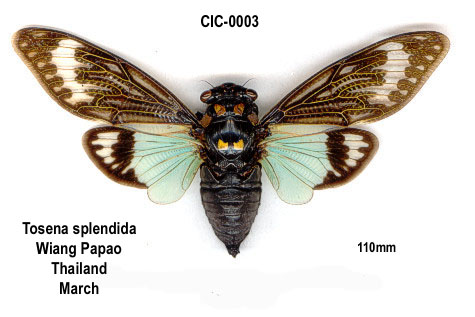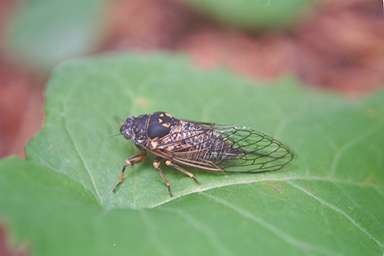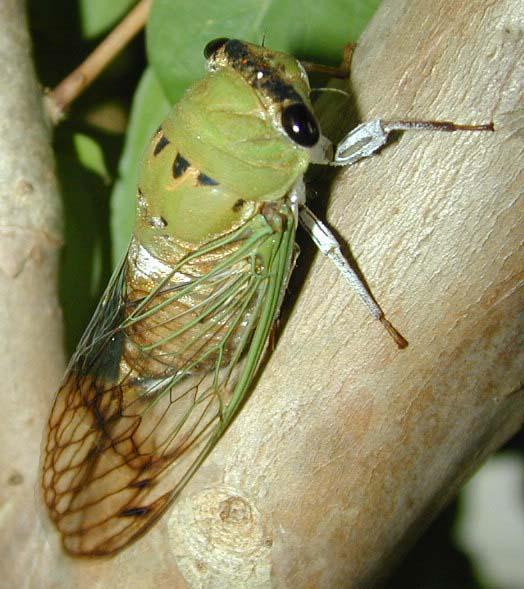Brood VI will next emerge in 2034.
This page was last updated in 2017.
Final Update: I traveled to Wisconsin last week and spent a few days looking for cicadas in the southern part of the state (Madison, Baraboo, Janesville, Cedar Bluff, Dodgeville) but unfortunately I did not see or hear any. :(. So far this year though, Brood VI was spotted in GA, NC, SC, OK, OH and perhaps NY….

Previous updates can be found in the comments.
Brood VI (6) 17-year cicadas (“locusts”) will emerge in the spring of 2017. The main group will emerge in South Carolina, North Carolina and Georgia. Other lesser groups should emerge in Ohio & Wisconsin. And possibly other states/locations as well.
About Brood VI:
The cicada species that will emerge are Magicicada septendecim1, Magicicada septendecula1, and possibly Magicicada cassini2. These periodical cicadas have a 17-year life cycle. The last time they emerged was 2000.
When: Generally speaking, these cicadas will begin to emerge when the soil 8" beneath the ground reaches 64 degrees Fahrenheit 3. A nice, warm rain will often trigger an emergence. So, definitely May, but something might happen in April if we have a particularly hot spring.
Report a sighting: If you see or heard cicadas, please report them to Cicadas @ UCONN (formerly Magicicada.org). This helps researchers map the location of the cicadas.
Locations where they are likely to emerge:
Georgia:
Counties:
Best bet: Rabun.6
1889 document: Dade (Trenton), Elbert (Elberton), Floyd (Rome), Habersham (Turnerville), Hill (Virgil), Paulding (Brownsville), Rabun, Spalding (Experiment), White (Tesnatee). 7
Not Atlanta.
North Carolina:
Counties:
Best bet: Buncombe (Asheville), Burke, Caldwell, Henderson, McDowell, Polk, Wilkes6.
1889 document: Alexander (Mount Pisgah, Taylorsville), Bladen, Buncombe (Asheville), Burke (Morganton), Cabarrus, Caldwell (Lenoir, Hickory), Catawba (Claremont, Maiden), Henderson (Westfeldt Park, Horse Shoe), Iredell, Lincoln (Denver, Lincolnton), Macon (Franklin), McDowell (Greenlee), Moore, Montgomery, Pender (Long Creek), Polk (Columbus, Saluda, Mill Spring), Rabun (Highlands), Randolph, Rutherford, Swain (Whittier), Transylvania, Union (Waxhaw), Washington, Wilkes (Moravian Falls, Wilkesboro).7
South Carolina:
Counties:
Best bet: Oconee, Pickens6.
1889 document: Oconee (Stumphouse Mountain which is near Westminster).7

Wisconsin:
Wisconsin seems like a sure thing as well.
Counties:
Best bet: Columbia, Dane, Rock, Sauk (Baraboo)5
1889 document (aside from those mentioned above: Burnett (Spooner), Columbia (Madison), Crawford (Towerville), Dane (Janesville), Fond du Lac (Ripon), Green Lake (Dartford), Marquette (Harrisville), Sauk (Baraboo), Sawyer (Hayward), Washburn (Shell Lake), Waushara (Auroraville). 7
Ohio
Counties:
Best bet: Hamilton (Hyde Park, Delhi, Finneytown, Green Township, Anderson). 5
1889 document: Carroll, Champaign, Columbiana, Delaware, Madison, Mahoning, Montgomery, Morrow, Pickaway, Shelby, Union.
And Maybe…
Various counties in Delaware, Illinois, Indiana, Kentucky, Maryland, Michigan, New Jersey, New York, Oklahoma, Pennsylvania, Tennessee, Virginia, and West Virginia. More about that here.
Learn more about Brood VI:

Download a PDF of the wanted poster (1.3MB).
















